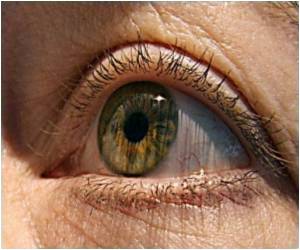Spectacles incorporating the latest computer technology are on display at the Royal Society Summer Science Exhibition that opened in London on Tuesday.

The glasses could come in handy for those suffering from common types of visual impairment such as age-related macular degeneration and diabetic retinopathy.
‘The types of poor vision we are talking about are where you might be able to see your own hand moving in front of you, but you can’t define the fingers,’ explains Dr Stephen Hicks of the Department of Clinical Neurology. The glasses have video cameras mounted at the corners to capture what the wearer is looking at, while a display of tiny lights embedded in the see-through lenses of the glasses feedback extra information about objects, people or obstacles in view.
In between, a smartphone-type computer running in your pocket recognises objects in the video image or tracks where a person is, driving the lights in the display in real time.
The extra information the glasses display about their surroundings should allow people to navigate round a room, pick out the most relevant things and locate objects placed nearby.
‘The glasses must look discrete, allow eye contact between people and present a simplified image to people with poor vision, to help them maintain independence in life,’ says Stephen. These guiding principles are important for coming up with an aid that is acceptable for people to wear in public, with eye contact being so important in social relationships, he explains.
Advertisement
Stephen even suggests it may be possible for the technology to read back newspaper headlines. He says something called optical character recognition is coming on, so it possible to foresee a computer distinguishing headlines from a video image then have these read back to the wearer through earphones coming with the glasses. A whole stream of such ideas and uses are possible, he suggests. There are barcode readers in some mobile phones that download the prices of products; such barcode and price tag readers could also be useful additions to the glasses.
Advertisement
He adds that people will have to get used to the extra information relayed on the glasses’ display, but that it might be similar to physiotherapy – the glasses will need to be tailored for individuals, their vision and their needs, and it will take a bit of time and practise to start seeing the benefits.
The exhibit at the Royal Society will take visitors through how the technology will work. ‘The primary aim is to simulate the experience of a visual prosthetic to give people an idea of what can be seen and how it might look,’ Stephen says.
A giant screen with video images of the exhibition floor itself will show people-tracking and depth perception at work. Another screen will invite visitors to see how good they are at navigating with this information. A small display added to the lenses of ski goggles should give people sufficient information to find their way round a set of tasks. An early prototype of a transparent LED array for the eventual glasses will also be on display.
All of this is very much at an early stage. The group is still assembling prototypes of their glasses. But as well as being one of the featured stands at the Royal Society’s exhibition, they have funding from the National Institute of Health Research to do a year-long feasibility study and plan to try out early systems with a few people in their own homes later this year.
Source-Medindia







